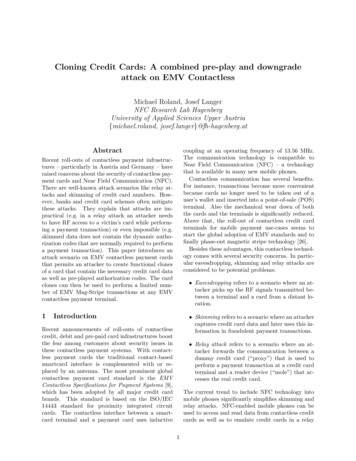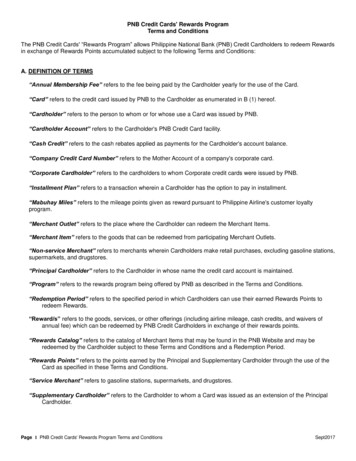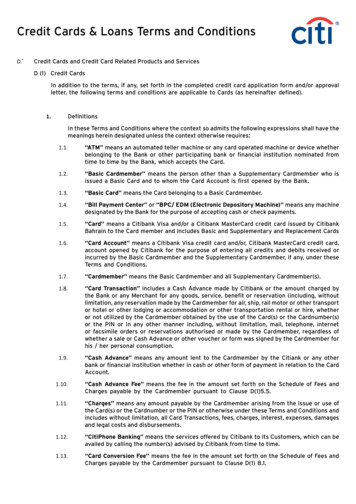
Transcription
Cloning Credit Cards: A combined pre-play and downgradeattack on EMV ContactlessMichael Roland, Josef LangerNFC Research Lab HagenbergUniversity of Applied Sciences Upper Austria{michael.roland, josef.langer}@fh-hagenberg.atAbstractcoupling at an operating frequency of 13.56 MHz.The communication technology is compatible toNear Field Communication (NFC) – a technologythat is available in many new mobile phones.Contactless communication has several benefits.For instance, transactions become more convenientbecause cards no longer need to be taken out of auser’s wallet and inserted into a point-of-sale (POS)terminal. Also the mechanical wear down of boththe cards and the terminals is significantly reduced.Above that, the roll-out of contactless credit cardterminals for mobile payment use-cases seems tostart the global adoption of EMV standards and tofinally phase-out magnetic stripe technology [26].Besides these advantages, this contactless technology comes with several security concerns. In particular eavesdropping, skimming and relay attacks areconsidered to be potential problems:Recent roll-outs of contactless payment infrastructures – particularly in Austria and Germany – haveraised concerns about the security of contactless payment cards and Near Field Communication (NFC).There are well-known attack scenarios like relay attacks and skimming of credit card numbers. However, banks and credit card schemes often mitigatethese attacks. They explain that attacks are impractical (e.g. in a relay attack an attacker needsto have RF access to a victim’s card while performing a payment transaction) or even impossible (e.g.skimmed data does not contain the dynamic authorization codes that are normally required to performa payment transaction). This paper introduces anattack scenario on EMV contactless payment cardsthat permits an attacker to create functional clonesof a card that contain the necessary credit card dataas well as pre-played authorization codes. The cardclones can then be used to perform a limited number of EMV Mag-Stripe transactions at any EMVcontactless payment terminal.1 Eavesdropping refers to a scenario where an attacker picks up the RF signals transmitted between a terminal and a card from a distant location.Introduction Skimming refers to a scenario where an attackercaptures credit card data and later uses this information in fraudulent payment transactions.Recent announcements of roll-outs of contactlesscredit, debit and pre-paid card infrastructures boostthe fear among customers about security issues inthese contactless payment systems. With contactless payment cards the traditional contact-basedsmartcard interface is complemented with or replaced by an antenna. The most prominent globalcontactless payment card standard is the EMVContactless Specifications for Payment Systems [9],which has been adopted by all major credit cardbrands. This standard is based on the ISO/IEC14443 standard for proximity integrated circuitcards. The contactless interface between a smartcard terminal and a payment card uses inductive Relay attack refers to a scenario where an attacker forwards the communication between adummy credit card (“proxy”) that is used toperform a payment transaction at a credit cardterminal and a reader device (“mole”) that accesses the real credit card.The current trend to include NFC technology intomobile phones significantly simplifies skimming andrelay attacks. NFC-enabled mobile phones can beused to access and read data from contactless creditcards as well as to emulate credit cards in a relay1
attack or based on data previously skimmed from acard.In this paper, we present a new attack scenariobased on skimming that can be used to create cardclones that successfully perform the EMV MagStripe protocol for contactless payment cards defined in the EMV Contactless Kernel 2 specification[8]. Valid dynamic card verification codes (CVC)which are necessary to authorize these payments areobtained from an original card with a pre-play approach. Further, we observed a second weaknesswith credit cards from various issuers which allowsto downgrade a full EMV credit card to perform acontactless EMV Mag-Stripe transaction.2This attack simply extends the communication distance between a genuine credit card terminal and agenuine credit card. Thus, a team of two attackerscan forward the communication of a credit card terminal (operated by attacker A) to a victim’s creditcard (operated by attacker B). Hancke [15] foundthat the relay attack is particularly useful in combination with contactless smartcards: In that case attacker B does not need to be in physical possessionof the relayed credit card but, instead, only needs toplace the mole in close proximity to the card-underattack.The current trend to include NFC technology intomobile phones significantly simplifies skimming andrelay attacks. Francis et al. [10, 11] propose the useof NFC-enabled mobile phones as platforms for attacks against ISO/IEC 14443 based smartcard systems. NFC-enabled mobile phones can be used inreader/writer mode to access contactless credit cardsto extract data for skimming or to relay communication to a proxy in a relay attack (cf. [1,12,13]). Incard emulation mode, an NFC-enabled mobile phonecould be used as a card-clone in a skimming attackor as the proxy in a relay attack (cf. [10, 13]).Nevertheless, particularly skimming is hindered inmodern chip-based credit cards by the use of “strongcryptography”. While potentially sensitive information (e.g. the credit card number, the expiry date,and – with older cards – also the cardholder’s name[17]) can be skimmed from contactless credit cards,this information is usually considered insufficient toconduct a fraudulent payment transaction. Though,the static information that is freely readable fromthe chip would be enough to pay at some online merchants (e.g. Amazon), most merchants would requirethe card verification code that is written on the backof the card. However, this code is not available onthe chip. Instead, the chip authorizes transactionsbased on a secret key that is securely stored insidethe smartcard chip and that cannot be read throughsmartcard commands.Despite their use of secure smartcard technologyand state-of-the-art cryptography, even chip-basedpayment cards have known weaknesses. For instance, there is a well-known issue with the offlinePIN verification protocol of EMV’s Chip & PIN discovered by Murdoch et al. [21]. This weakness allows to completely bypass PIN verification on certain cards. A new attack described by Bond etal. [2] reveals that many EMV terminal implementations trade security for simplicity: Supposedly unpredictable (random) numbers generated by theseimplementations for use in cryptographic protocolsbecome predictable. As a consequence, the “strong”Related WorkHaselsteiner and Beitfuß [16] describe eavesdroppingas an important issue of wireless communicationtechnologies. They suggest that, while normal communication distances for ISO/IEC 14443 and NFCare at most 10 centimeters, eavesdropping is possibleeven if there is a distance of several meters betweenthe attacker and the attacked devices.While eavesdropping extracts information from legitimate communication between a credit card anda payment terminal, skimming uses any informationthat could potentially be used to perform a fraudulent payment transaction. This information couldbe obtained through directly reading data from acard, through eavesdropping or even through socialengineering. Credit card data may range from cardholder names, credit card numbers and card verification codes to digital data extracted from real creditcards. Sufficient information for skimming could beobtained by means as simple as photocopying theplastic card or by harvesting in call centers [18].However, already articles from the early 1990s [4,6,7]explain how to decode the magnetic stripe of acredit card and how to encode this information ontoa blank card in order to create a functional cardclone. Today, these credit card clones are often created by harvesting magnetic stripe data as well asPIN codes at ATMs [14]. With contactless paymentcards, skimming may be possible even without being in physical possession of a card. For instance,Paget [22] describes how to extract static data fromchip-based credit cards to later encode this information onto magnetic stripe cards. Even though thatinformation lacked card verification codes the cardclones were accepted by certain merchants.Another scenario, the relay attack, was initiallydescribed by Conway [3] as the “Grandmaster ChessAttack” and by Desmedt et al. [5] as “mafia fraud”.2
cryptographic protocols are severely weakened. Dueto the weakened cryptographic protocol, an attackercould calculate a series of transaction authorizationswith a real credit card in advance. Later, these precalculated authorizations could be used on a cardclone to perform actual payment transactions (or towithdraw cash at an ATM).Our attack scenario uses an approach similar tothat by Bond et al. [2]. It also aims at abusingweakened cryptographic protocols to perform a preplay attack. While their approach targets specificterminal implementations that have predictable random number generators, our approach targets general limitations of the EMV contactless protocol inMag-Stripe mode. Compared to the attack by Bondet al. [2], our attack does not require the authorizedamount to be known during the pre-calculation.Moreover, our attack does not need any specificknowledge about the implementation and the initialization state of the random number generator ofthe terminal that is later fed with the pre-playeddata. However, our attack is limited by the maximum amount that can be authorized with a PIN-lesscontactless transaction.3Mag-Stripe mode transactions and may optionallysupport EMV mode transactions. Moreover, MasterCard’s rules [19] suggest that within the SingleEuropean Payment Area (SEPA), cards and terminals issued in 2011 and later must support both,PayPass EMV mode and PayPass Mag-Stripe mode.PayPass cards using the Maestro brand, however,must never support contactless Mag-Stripe [20].In EMV mode, the static data contained in thecard is signed by the card issuer. Thus, the paymentterminal can verify that the card data is authentic.In addition the card signs the payment transactionusing a secret key that is only known to the cardand that can usually not be extracted from the card.This can be used to verify that the card itself is authentic. As a consequence, a payment terminal couldeven verify and store transactions authenticated bya card offline for later processing.Compared to processing a classic magnetic stripetransaction, the authorization of EMV mode transactions requires additional interfaces between thepayment terminals, the acquiring bank and the cardissuer. In order to also use the existing magneticstripe infrastructure without significant modifications, Kernel 2 supports Mag-Stripe mode.In Mag-Stripe mode, the card stores informationcomparable to the data on a magnetic stripe. Instead of a static authentication code encoded intothe Mag-Stripe data (or printed on the back of thecard), the card generates dynamic authenticationcodes to authorize payments. The authenticationcode (dynamic card verification code, CVC3) authenticates only the card and not the contents ofa payment transaction. The codes are calculatedfrom secret key material that is only known to thecard and its issuer. Besides the secret key, the dynamic CVC3 is derived from a transaction counter(ATC) that is incremented by the card for each generated code and an unpredictable number (UN) thatis provided by the POS terminal. The transactioncounter hinders re-use of previously used authentication codes (re-play). The unpredictable numberhinders pre-generation of authentication codes ona real card for later use in fraudulent transactions(pre-play).A typical Mag-Stripe mode contactless credit cardtransaction consists of the following smartcard command sequence (a detailed trace can be found inAppendix A):EMV Contactless Kernel 2The EMV Contactless Specifications for PaymentSystems [9] come in four different flavors: Kernel1, 2, 3, and 4. They are named “kernel” specifications as they primarily target the terminal software implementation for interacting with compliantpayment cards. Each kernel specification covers thepayment systems of specific credit card brands.Our discoveries focus on the Kernel 2 Specification [8], though we have not looked for similarities inother kernel specifications. According to the specification document, Kernel 2 covers the protocols required to interact with payment cards supportingthe MasterCard PayPass brand or any other payment card that explicitly requests usage of Kernel2 [8].The EMV protocol of Kernel 2 supports two different operating modes: emulation of the magneticstripe system over contactless transactions (MagStripe mode) and the full EMV protocol (EMVmode).According to MasterCard’s requirement specification for PayPass M/Chip [20], a PayPass cardusing the MasterCard brand must always supportcontactless Mag-Stripe mode transactions and mayoptionally support EMV mode transactions. Similarly, that specification requires that MasterCardPayPass terminals must always support contactless1. The POS selects (SELECT command) theProximity Payment System Environment(PPSE) and the card responds with a list ofsupported EMV payment applications.3
42. The POS selects (SELECT command) thecredit/debit card application and the card responds with application details.Attack SurfaceDuring our evaluation of EMV contactless credit/debit cards, we identified several weaknesses in Kernel 2’s Mag-Stripe protocol and in current authorization systems. An attacker could use these weaknesses to create functional card clones from existingcontactless payment cards.In the first attack scenario, a pre-play attack, theattacker pre-calculat
credit card and how to encode this information onto a blank card in order to create a functional card clone. Today, these credit card clones are often cre- ated by harvesting magnetic stripe data as well as PIN codes at ATMs [14]. With contactless payment cards, skimming may be possible even without be-ing in physical possession of a card. For instance, Paget [22] describes how to extract .











